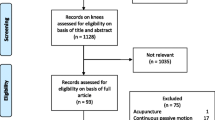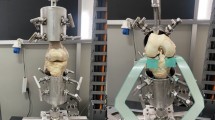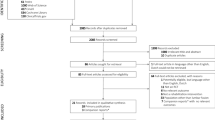Abstract
Introduction
Patients with femoroacetabular impingement syndrome (FAIS) experience decreased function. Consequently, earlier studies have evaluated gait biomechanics in these patients, but a larger study evaluating gait biomechanics before and after an intervention standardising gait speed is lacking. We aimed at investigating gait kinematics and kinetics in patients with FAIS compared with pain-free controls before and 1 year after hip arthroscopic surgery. Secondary, we aimed at analysing gait pattern separately for the sexes and to investigate associations between peak kinematics and kinetics and the Copenhagen Hip and Groin Outcome Score (HAGOS).
Materials and methods
Sixty patients with FAIS and 30 pain-free controls were tested at a standardised gait speed (1.40 m/s ± 10%). Patients were tested twice: before and 1 year after surgery. Kinematics and kinetics were recorded using infrared high-speed cameras and a force plate. Participants answered HAGOS.
Results
The largest difference among groups was that gait differed between males and females. Neither before nor after surgery could we demonstrate large alterations in gait pattern between patients and pain-free controls. Male patients demonstrated associations between peak kinematics and kinetics and HAGOS Sports function.
Conclusions
Gait pattern was only vaguely altered in patients with FAIS compared with pain-free controls before and after surgery when using at standardised gait speed. Hence, analysing gait in patients with FAIS does not seem of major importance. Nevertheless, there was an association between HAGOS Sports function and peak kinematics and kinetics in male patients, implying that there could be a clinical importance.







Similar content being viewed by others
References
Nielsen TG, Miller LL, Lund B, Christiansen SE, Lind M (2014) Outcome of arthroscopic treatment for symptomatic femoroacetabular impingement. BMC Musculoskelet Disord 15:394. https://doi.org/10.1186/1471-2474-15-394
Kierkegaard S, Langeskov-Christensen M, Lund B, Naal FD, Mechlenburg I, Dalgas U, Casartelli NC (2017) Pain, activities of daily living and sport function at different time points after hip arthroscopy in patients with femoroacetabular impingement: a systematic review with meta-analysis. Br J Sports Med 51(7):572–579. https://doi.org/10.1136/bjsports-2016-096618
Hoch A, Schenk P, Jentzsch T, Rahm S, Zingg PO (2021) FAI morphology increases the risk for osteoarthritis in young people with a minimum follow-up of 25 years. Arch Orthop Trauma Surg 141(7):1175–1181. https://doi.org/10.1007/s00402-020-03522-3
Agricola R, Heijboer MP, Bierma-Zeinstra SM, Verhaar JA, Weinans H, Waarsing JH (2013) Cam impingement causes osteoarthritis of the hip: a nationwide prospective cohort study (CHECK). Ann Rheum Dis 72(6):918–923. https://doi.org/10.1136/annrheumdis-2012-201643
Ganz R, Parvizi J, Beck M, Leunig M, Notzli H, Siebenrock KA (2003) Femoroacetabular impingement: a cause for osteoarthritis of the hip. Clin Orthop Relat Res 417:112–120. https://doi.org/10.1097/01.blo.0000096804.78689.c2
Naal FD, Miozzari HH, Schar M, Hesper T, Notzli HP (2012) Midterm results of surgical hip dislocation for the treatment of femoroacetabular impingement. Am J Sports Med 40(7):1501–1510. https://doi.org/10.1177/0363546512445884
Kelly BT, Bedi A, Robertson CM, Dela Torre K, Giveans MR, Larson CM (2012) Alterations in internal rotation and alpha angles are associated with arthroscopic cam decompression in the hip. Am J Sports Med 40(5):1107–1112. https://doi.org/10.1177/0363546512437731
Freke MD, Kemp J, Svege I, Risberg MA, Semciw A, Crossley KM (2016) Physical impairments in symptomatic femoroacetabular impingement: a systematic review of the evidence. Br J Sports Med 50(19):1180. https://doi.org/10.1136/bjsports-2016-096152
King MG, Lawrenson PR, Semciw AI, Middleton KJ, Crossley KM (2018) Lower limb biomechanics in femoroacetabular impingement syndrome: a systematic review and meta-analysis. Br J Sports Med 52(9):566–580. https://doi.org/10.1136/bjsports-2017-097839
Lewis CL, Khuu A, Loverro KL (2018) Gait alterations in femoroacetabular impingement syndrome differ by sex. J Orthop Sports Phys Ther 48(8):649–658. https://doi.org/10.2519/jospt.2018.7913
Kierkegaard S, Lund B, Dalgas U, Sorensen H, Soballe K, Mechlenburg I (2015) The Horsens-Aarhus femoro acetabular impingement (HAFAI) cohort: outcome of arthroscopic treatment for femoroacetabular impingement. Protocol for a prospective cohort study. BMJ Open. https://doi.org/10.1136/bmjopen-2015-008952
Kierkegaard S, Mechlenburg I, Lund B, Soballe K, Dalgas U (2017) Impaired hip muscle strength in patients with femoroacetabular impingement syndrome. J Sci Med Sport/Sports Med Austr 20(12):1062–1067. https://doi.org/10.1016/j.jsams.2017.05.008
Kierkegaard S, Mechlenburg I, Lund B, Romer L, Soballe K, Dalgas U (2019) Is hip muscle strength normalised in patients with femoroacetabular impingement syndrome one year after surgery?: Results from the HAFAI cohort. J Sci Med Sport/Sports Med Austr 22(4):413–419. https://doi.org/10.1016/j.jsams.2018.10.004
Kierkegaard S, Dalgas U, Lund B, Lipperts M, Soballe K, Mechlenburg I (2020) Despite patient-reported outcomes improve, patients with femoroacetabular impingement syndrome do not increase their objectively measured sport and physical activity level 1 year after hip arthroscopic surgery. Results from the HAFAI cohort. Knee Surg Sports Traumatol Arthroscopy Official J ESSKA 28(5):1639–1647. https://doi.org/10.1007/s00167-019-05503-5
Thorborg K, Holmich P, Christensen R, Petersen J, Roos EM (2011) The copenhagen hip and groin outcome score (HAGOS): development and validation according to the COSMIN checklist. Br J Sports Med 45(6):478–491. https://doi.org/10.1136/bjsm.2010.080937
Brisson N, Lamontagne M, Kennedy MJ, Beaule PE (2013) The effects of cam femoroacetabular impingement corrective surgery on lower-extremity gait biomechanics. Gait Posture 37(2):258–263
Rylander J, Shu B, Favre J, Safran M, Andriacchi T (2013) Functional testing provides unique insights into the pathomechanics of femoroacetabular impingement and an objective basis for evaluating treatment outcome. J Orthop Res 31(9):1461–1468
Jacobsen JS, Nielsen DB, Sorensen H, Soballe K, Mechlenburg I (2014) Joint kinematics and kinetics during walking and running in 32 patients with hip dysplasia 1 year after periacetabular osteotomy. Acta Orthopaed. https://doi.org/10.3109/17453674.2014.960167
Diamond LE, Wrigley TV, Bennell KL, Hinman RS, O’Donnell J, Hodges PW (2016) Hip joint biomechanics during gait in people with and without symptomatic femoroacetabular impingement. Gait Posture 43:198–203. https://doi.org/10.1016/j.gaitpost.2015.09.023
Hunt MA, Guenther JR, Gilbart MK (2013) Kinematic and kinetic differences during walking in patients with and without symptomatic femoroacetabular impingement. Clin Biomech (Bristol, Avon) 28(5):519–523. https://doi.org/10.1016/j.clinbiomech.2013.05.002
Bruening DA, Frimenko RE, Goodyear CD, Bowden DR, Fullenkamp AM (2015) Sex differences in whole body gait kinematics at preferred speeds. Gait Posture 41(2):540–545. https://doi.org/10.1016/j.gaitpost.2014.12.011
Kennedy MJ, Lamontagne M, Beaule PE (2009) Femoroacetabular impingement alters hip and pelvic biomechanics during gait Walking biomechanics of FAI. Gait Posture 30(1):41–44. https://doi.org/10.1016/j.gaitpost.2009.02.008
Hetsroni I, Funk S, Ben-Sira D, Nyska M, Palmanovich E, Ayalon M (2015) Femoroacetabular impingement syndrome is associated with alterations in hindfoot mechanics: a three-dimensional gait analysis study. Clin Biomech (Bristol, Avon) 30(10):1189–1193. https://doi.org/10.1016/j.clinbiomech.2015.08.005
Samaan MA, Schwaiger BJ, Gallo MC, Sada K, Link TM, Zhang AL, Majumdar S, Souza RB (2017) Joint loading in the sagittal plane during gait is associated with hip joint abnormalities in patients with femoroacetabular impingement. Am J Sports Med 45(4):810–818. https://doi.org/10.1177/0363546516677727
Catelli DS, Ng KCG, Kowalski E, Beaule PE, Lamontagne M (2019) Modified gait patterns due to cam FAI syndrome remain unchanged after surgery. Gait Posture 72:135–141. https://doi.org/10.1016/j.gaitpost.2019.06.003
Kumar D, Dillon A, Nardo L, Link TM, Majumdar S, Souza RB (2014) Differences in the association of hip cartilage lesions and cam-type femoroacetabular impingement with movement patterns: a preliminary study. PM R 6(8):681–689. https://doi.org/10.1016/j.pmrj.2014.02.002
Heerey J, Agricola R, Smith A, Kemp J, Pizzari T, King M, Lawrenson P, Scholes M, Crossley K (2021) The size and prevalence of bony hip morphology do not differ between football players with and without hip and/or groin pain: findings from the FORCe cohort. J Orthop Sports Phys Ther 51(3):115–125. https://doi.org/10.2519/jospt.2021.9622
Catelli DS, Kowalski E, Beaule PE, Smit K, Lamontagne M (2018) Asymptomatic participants with a femoroacetabular deformity demonstrate stronger hip extensors and greater pelvis mobility during the deep squat task. Orthop J Sports Med 6(7):2325967118782484. https://doi.org/10.1177/2325967118782484
Acknowledgements
We would like to thank Sebastian Skejø for his invaluable help with data analysis.
Funding
This study was funded by Gigtforeningen, The Health Research Fund for the Central Region of Denmark, Augustinus Fonden, Aase og Ejnar Danielsens Fond, Direktør Jacob Madsen og Hustru Olga Madsens Fond, Fonden til Lægevidenskabens Fremme, Familien Hede Nielsens Fond, Gurli & Hans Engell Friis Foundation, and Horsens Regional Hospital.
Author information
Authors and Affiliations
Corresponding author
Ethics declarations
Conflict of interest
The authors declare no conflicts of interest.
Ethics committee
The study was approved by the Central Denmark Region Committee on Biomedical Research Ethics (1–10-72–239-14) and the Danish Data Protection Agency (1–16-02–499-14).
Public trials registry
The study was registered at clinical trials.org (NCT02306525).
Additional information
Publisher's Note
Springer Nature remains neutral with regard to jurisdictional claims in published maps and institutional affiliations.
Supplementary Information
Below is the link to the electronic supplementary material.
Rights and permissions
About this article
Cite this article
Kierkegaard, S., Mechlenburg, I., Dalgas, U. et al. Hip kinematics and kinetics in patients with femoroacetabular impingement syndrome before and 1 year after hip arthroscopic surgery. Results from the HAFAI cohort. Arch Orthop Trauma Surg 142, 2019–2029 (2022). https://doi.org/10.1007/s00402-021-04209-z
Received:
Accepted:
Published:
Issue Date:
DOI: https://doi.org/10.1007/s00402-021-04209-z




